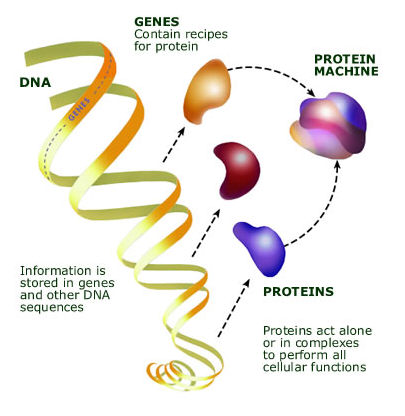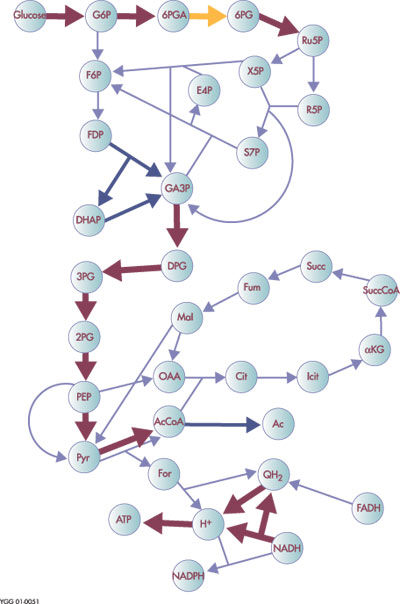Pocket K No. 15: 'Omics' Sciences: Genomics, Proteomics, and Metabolomics
| |
Genomics
|
Genomics is the new science that deals with the discovery and noting of all the sequences in the entire genome of a particular organism. The genome can be defined as the complete set of genes inside a cell. Genomics, is, therefore, the study of the genetic make-up of organisms.
Determining the genomic sequence, however, is only the beginning of genomics. Once this is done, the genomic sequence is used to study the function of the numerous genes (functional genomics), to compare the genes in one organism with those of another (comparative genomics), or to generate the 3-D structure of one or more proteins from each protein family, thus offering clues to their function (structural genomics).
In crop agriculture, the main purpose of the application of genomics is to gain a better understanding of the whole genome of plants. Agronomically important genes may be identified and targeted to produce more nutritious and safe food while at the same time preserving the environment.
Genomics is an entry point for looking at the other ‘omics’ sciences. The information in the genes of an organism, its genotype, is largely responsible for the final physical makeup of the organism, referred to as the “phenotype”. However, the environment also has some influence on the phenotype.
DNA in the genome is only one aspect of the complex mechanism that keeps an organism running – so decoding the DNA is one step towards understanding the process. However, by itself, it does not specify everything that happens within the organism.
The basic flow of genetic information in a cell is as follows. The DNA is transcribed or copied into a form known as “RNA”. The complete set of RNA (also known as its transcriptome) is subject to some editing (cutting and pasting) to become messenger-RNA, which carries information to the ribosome, the protein factory of the cell, which then translates the message into protein.
Figure 1. Genes, proteins, and molecular machines |
|
Source: U.S. Department of Energy Genomes to Life Program, http://doegenomestolife.org |
The International Rice Genome Sequencing Project
|
This ongoing genomic research in rice is a collaborative effort of several public and private laboratories worldwide. This project aims to completely sequence the entire rice genome (12 rice chromosomes) and subsequently apply the knowledge to improve rice production.
In 2002, the draft genome sequences of two agriculturally important subspecies of rice, indica and japonica, were published. Once completed, the rice genome sequence will serve as a model system for other cereal grasses and will assist in identifying important genes in maize, wheat, oats, sorghum, and millet.
For more, visit http://rgp.dna.affrc.go.jp/IRGSP
Proteomics
Proteins are responsible for an endless number of tasks within the cell. The complete set of proteins in a cell can be referred to as its proteome and the study of protein structure and function and what every protein in the cell is doing is known as proteomics. The proteome is highly dynamic and it changes from time to time in response to different environmental stimuli. The goal of proteomics is to understand how the structure and function of proteins allow them to do what they do, what they interact with, and how they contribute to life processes.
An application of proteomics is known as protein “expression profiling” where proteins are identified at a certain time in an organism as a result of the expression to a stimulus. Proteomics can also be used to develop a protein-network map where interaction among proteins can be determined for a particular living system.
Proteomics can also be applied to map protein modification to determine the difference between a wild type and a genetically modified organism. It is also used to study protein-protein interactions involved in plant defense reactions.
|
For example, proteomics research at Iowa State University, USA includes:
- an examination of changes of protein in the corn proteome during low temperatures which is a major problem for young corn seedlings;
- analysis of the differences that occur in the genome expression in developing soybean stressed by high temperatures; and
- identifying the proteins expressed in response to diseases like soybean cyst nematode.
Metabolomics
Metabolomics is one of the newest ‘omics’ sciences. The metabolome refers to the complete set of low molecular weight compounds in a sample. These compounds are the substrates and by-products of enzymatic reactions and have a direct effect on the phenotype of the cell. Thus, metabolomics aims at determining a sample’s profile of these compounds at a specified time under specific environmental conditions.
Genomics and proteomics have provided extensive information regarding the genotype but convey limited information about phenotype. Low molecular weight compounds are the closest link to phenotype.
Metabolomics can be used to determine differences between the levels of thousands of molecules between a healthy and diseased plant. The technology can also be used to determine the nutritional difference between traditional and genetically modified crops, and in identifying plant defense metabolites.
Figure 2. Example of a metabolic network model for E. coli |
|
Source: U.S. Department of Energy Genomes to Life Program, http://doegenomestolife.org |
Figure 2. Example of a metabolic network model for E. coli |
|
Source: http://biotech.nature.com |
Genomics provides an overview of the complete set of genetic instructions provided by the DNA, while transcriptomics looks into gene expression patterns. Proteomics studies dynamic protein products and their interactions, while metabolomics is also an intermediate step in understanding organism’s entire metabolism.
Glossary
Chromosome: a grouping of coiled strands of DNA, containing many genes.
DNA (deoxyribonucleic acid): a molecule found in cells of organisms that encodes genetic information.
Gene: a biological unit that codes for distinct traits or characteristics.
Genome: the complete set of genes in a cell.
Genotype: the genetic constitution of an organism.
Metabolome: complete set of low molecular weight compounds in a cell at a given time.
Phenotype: the physical appearance/observable characteristics of an organism.
Proteome: complete set of proteins in a cell at a given time.
RNA (ribonucleic acid): a molecule, derived from DNA by transcription, that either carries information (messenger RNA), provides sub-cellular structure (ribosomal RNA), transports amino acids (transfer RNA), or facilitates the biochemical modification of itself or other RNA molecules.
| |
References:
- Genomics and Its impact on Medicine and Society. A 2001 primer. http://www.ornl.gov/TechResources/Human_Genome/publicat/primer2001/1.html
- Primer on Molecular Genetics. http://www.ornl.gov/TechResources/Human_Genome/publicat/primer/primer.pdf
- Plant Sciences Institute Update. Iowa State University. October 2001. Volume 2 No.1.
- Genome Projects. http://www.tigr.org/tdb
- Meet the ‘omics’ 2003 Agbiotech Infosource. Saskatchewan Agricultural Biotechnology Information Centre, A service of Ag-West Biotech Inc.
*November 2006






